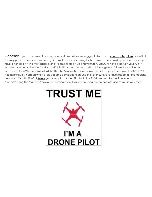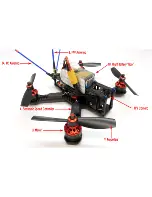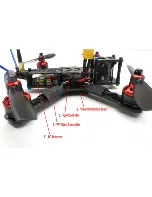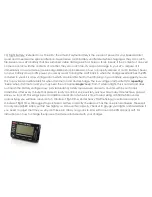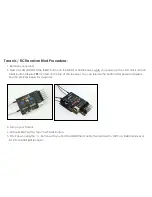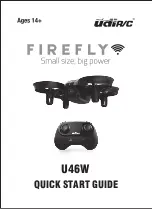
Steps for FPV Flight:
If you have never flown FPV before your first few flights may be somewhat disorienting. This is typical with most people.
Make sure to bring a spotter with you for your first few flights. This is important because it takes practice to be able to
quickly access your surroundings from the sky and determine where it is safe to direct the craft from one second to the
next. A second person can warn you of any approaching dangers that may not be in your field of view. It is also
important to be very familiar with the flight area BEFORE you go up. The FPV vision system has a range that is
determined by a number of factors. In general your FPV signal will be clearest when nothing is between you and the
craft. For your first few flights try to stay relatively close to yourself. Don't venture too far away. If you notice a
degradation in the signal turn the craft around and fly back towards your position. There is no way for us to teach you
in the scope of this manual how to fly FPV. The only way to learn is by trial and error. The instructions below are not
intended to be your bible for flying. They are simply general guidelines to aid you in your very first flight. Ideally, you
should seek out someone whom is skilled in flying FPV and ask for their assistance. This sport is becoming very popular
with many clubs popping up in communities around the world. Seek help from experienced pilots!
Step 1:
Preparations –
With your 210-R powered up, transmitter and goggles on, flip the three position mode switch to
towards yourself into 'Professional FPV flight mode'
.
Step 2:
Lift off
–
Arm the motors then slowly creep up on the throttle 'left stick' while slightly pushing forward on the
pitch 'right stick'. From here you are on your own. Have fun and be careful!
Step 3:
Landing
–
When you are ready to land flip the flight mode switch over to 'Beginner Line of Sight'. Most people
find landing to be easier in this 'self level mode' since the craft will tend to slow down and automatically work to stay
parallel to the ground. Make sure to flip the 'Motor Arm' switch back away from yourself to disarm the motors before
approaching the craft.
Summary of Contents for 210-R
Page 2: ...Section 1 Warnings and Warranty...
Page 5: ...Section 2 Controls...
Page 6: ......
Page 10: ...Section 3 Steps to Get in the Air...
Page 11: ......
Page 12: ......
Page 13: ......
Page 22: ...Section 4 Taranis Binding and Setup BNF 210 R...
Page 27: ...Section 5 Troubleshooting...
Page 31: ...goggles with a good 5 8 Ghz receiver is very important...





